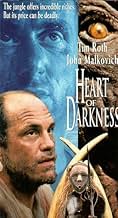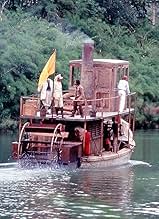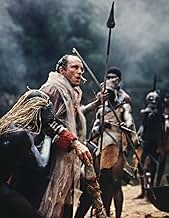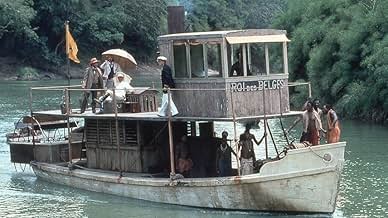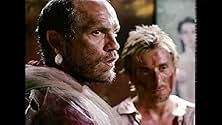IMDb RATING
5.7/10
2.2K
YOUR RATING
A trading company manager travels up an African river to find a missing outpost head and discovers the depth of evil in humanity's soul.A trading company manager travels up an African river to find a missing outpost head and discovers the depth of evil in humanity's soul.A trading company manager travels up an African river to find a missing outpost head and discovers the depth of evil in humanity's soul.
- Director
- Writers
- Stars
- Won 1 Primetime Emmy
- 3 wins & 3 nominations total
- Director
- Writers
- All cast & crew
- Production, box office & more at IMDbPro
Featured reviews
Heart of Darkness, directed by Nicolas Roeg, is an adaptation of Joseph Conrad's tale of ivory hunting in the African jungle. Heart of Darkness was a made for T.V. film, airing on March 13, 1994 on TNT (Turner Network Television). Auteur theorists analyzing previous Roeg films may agree that this T.V. adaptation does not hold the same attributes. One may argue that it was made for television, which would place guidelines on how much Roeg could express his autuerist style. Others may believe that Roeg' style is still at work within Heart of Darkness, even though it follows the Hollywood narrative. This film analysis will argue the Roeg elements are still at work. The film begins with extreme close ups of an elephants body. Next we see Marlow (Tim Roth) explaining his expedition of the African Jungle to a group of rich British men. From there, the film cuts to a large library or museum where we see two women in black, almost identical, sitting in the front entrance of an office. Marlow, in a voice over, begins to become uneasy with the women's presence. He makes comments to himself regarding a conspiracy and the women were warning him of something. If one has seen Don't Look Now (1973) they can make a predisposition toward the two women in black and the psychic sisters. Marlow had ambiguities toward the two women, just as John (Donald Sutherland) had toward the sisters, which predicted his outcome (death). Marlow on the other hand assumed danger from the two women and danger is exactly what he found in the Congo. As the film continues we see an aborigine standing outside of a window looking in at Marlow. We later find out that he committed suicide or was speared in the chest by an unruly army headed by Kurtz (John Malkovich). In Walkabout (1971) we see the young aborigine looking into the house at the white girl. In both films the aborigine's are looking into the white man's world. Unfortunately they find the white man's world can be destructive and greedy, as seen in the Kurtz controlled outlandish army. They steal young boys and barter them for supplies. Three young boys are abducted from the camp site, one boy is killed and the others are returned for supplies.
Previous to the abduction, we see random shots of a boy with an ivory necklace. We later see the necklace lying near where the boy had been sleeping. Immediately following the abduction is a dream sequence which Marlow sees a dead elephant, stripped of its' tusks, lying alongside a trail. Maggots are seen as the camera moves in for a close up. Juxtaposed with the elephant are the identical women and finally a claw tool. This sequence expresses the dangers associated with the Congo, not only on the explorers but aborigines and animals. These sequences are Roegian for its' underlying themes. What do two women, an elephant and a claw have to do with a journey in the Congo? The elephant is clearly associated with ivory and greed. The women mean a clear and present danger in the Congo. The claw depicts violence and is later seen sitting in Kurtz's hut. In one shot we see Mfumu looking into the water where it appears blood is floating on the surface, foreshadowing his own death. After he is speared Marlow throws his body overboard and blood floats atop the surface again. Roeg does not hold back on the grotesqueness within Heart of Darkness. In one scene we see another explorer repeatedly kicking and striking a black man. After Mfumu is speared, Marlow pulls on the spear and blood explodes from the chest. Surprisingly T.V. allowed this scene as well as a few others. Moments later Marlow and his guides enter Kurtz's village where there is a young boy covered in blood and tied to a tree. There are also boys' heads on stakes and on branches in trees. More boys are taken from the crew and traded, and one is killed. Kurtz's makes his appearance in the final 20 minutes of the film. He appears to be a god to the aborigine army. He is quite crazy and slowly dies away in a most unusual and unauthentic way. He is buried in an upright position and is draped in white cloth. There appears to be some sort of metal attachments from his upper body to his arms to keep them out in front of him. I am not sure what Roeg was getting at with this, but it may have to do with Kurtz being crazy and having instilled his own ideologies to the army. There is one theme in which is unusual. There is an aborigine woman that closely resembles Kurtz's white wife. The black beauty is framed with Kurtz's wife's painting. The black beauty appears to have some sort of skin ailment or body paint. Maybe Kurtz has put her up to painting or brandishing herself to slightly resemble his wife back in Britain. At the end of the film Marlow approaches the widow and tells her of Kurtz's last moments. This scene seems so out of place. The black and white woman reflecting each other in some sort of weird African fantasy makes sense, but Marlow actually going to see the widow has no real premise. It does appear Roeg intentionally mirrored Kurtz's loves, but the widow scene seemed so hurried. That did not at all seem Roegish. Finally the end montage near Kurtz's death is the most Roegistic style in the whole film. Roeg compiles every theme into about one minute of juxtaposed images containing Mfumu's death and the spear exiting his chest in slow motion. The elephant's rotting carcass, the two women being seen again, the ivory necklace and young boys are also shown again. Random shots of Kurtz's masked army are installed. The black and white women are repeated. Heart of Darkness is much so a Roeg film only with a T.V. limit.
Previous to the abduction, we see random shots of a boy with an ivory necklace. We later see the necklace lying near where the boy had been sleeping. Immediately following the abduction is a dream sequence which Marlow sees a dead elephant, stripped of its' tusks, lying alongside a trail. Maggots are seen as the camera moves in for a close up. Juxtaposed with the elephant are the identical women and finally a claw tool. This sequence expresses the dangers associated with the Congo, not only on the explorers but aborigines and animals. These sequences are Roegian for its' underlying themes. What do two women, an elephant and a claw have to do with a journey in the Congo? The elephant is clearly associated with ivory and greed. The women mean a clear and present danger in the Congo. The claw depicts violence and is later seen sitting in Kurtz's hut. In one shot we see Mfumu looking into the water where it appears blood is floating on the surface, foreshadowing his own death. After he is speared Marlow throws his body overboard and blood floats atop the surface again. Roeg does not hold back on the grotesqueness within Heart of Darkness. In one scene we see another explorer repeatedly kicking and striking a black man. After Mfumu is speared, Marlow pulls on the spear and blood explodes from the chest. Surprisingly T.V. allowed this scene as well as a few others. Moments later Marlow and his guides enter Kurtz's village where there is a young boy covered in blood and tied to a tree. There are also boys' heads on stakes and on branches in trees. More boys are taken from the crew and traded, and one is killed. Kurtz's makes his appearance in the final 20 minutes of the film. He appears to be a god to the aborigine army. He is quite crazy and slowly dies away in a most unusual and unauthentic way. He is buried in an upright position and is draped in white cloth. There appears to be some sort of metal attachments from his upper body to his arms to keep them out in front of him. I am not sure what Roeg was getting at with this, but it may have to do with Kurtz being crazy and having instilled his own ideologies to the army. There is one theme in which is unusual. There is an aborigine woman that closely resembles Kurtz's white wife. The black beauty is framed with Kurtz's wife's painting. The black beauty appears to have some sort of skin ailment or body paint. Maybe Kurtz has put her up to painting or brandishing herself to slightly resemble his wife back in Britain. At the end of the film Marlow approaches the widow and tells her of Kurtz's last moments. This scene seems so out of place. The black and white woman reflecting each other in some sort of weird African fantasy makes sense, but Marlow actually going to see the widow has no real premise. It does appear Roeg intentionally mirrored Kurtz's loves, but the widow scene seemed so hurried. That did not at all seem Roegish. Finally the end montage near Kurtz's death is the most Roegistic style in the whole film. Roeg compiles every theme into about one minute of juxtaposed images containing Mfumu's death and the spear exiting his chest in slow motion. The elephant's rotting carcass, the two women being seen again, the ivory necklace and young boys are also shown again. Random shots of Kurtz's masked army are installed. The black and white women are repeated. Heart of Darkness is much so a Roeg film only with a T.V. limit.
The movie version of Heart of Darkness has its similarities and differences to the novel. It lacks much of the information that Joseph Conrad wrote about, but still displays the story line decently. Because of this, many people did not enjoy the movie. I agree, but I believe it would be too difficult to make a movie-replica of that sort.
The book clearly makes you imagine the scenery and action as seen through Joseph Conrad's eyes. Life in Africa was not an easy picture to paint, but this clever author used his vast vocabulary and imagery skills to describe to readers his journey through the real "Heart of Darkness." The movie, however, had poorly-made backdrops and cheap scenery to act with. I feel that this was plenty enough to loose the attention of many viewers, including me. However, I defend them to say that it would be far too hard to find the place Conrad had once adventured through. Page after page was the story of his trip, but the movie only had about two hours to try and even begin to explain what he went through.
Personally, I would recommend watching the movie IF and ONLY if you have read and have a basic understanding of the novel. My expectations were not met, but I would consider giving it a try. Even though the movie was only about a quarter accurate, the director, alongside the actors, had plenty of good intentions while making this movie.
The book clearly makes you imagine the scenery and action as seen through Joseph Conrad's eyes. Life in Africa was not an easy picture to paint, but this clever author used his vast vocabulary and imagery skills to describe to readers his journey through the real "Heart of Darkness." The movie, however, had poorly-made backdrops and cheap scenery to act with. I feel that this was plenty enough to loose the attention of many viewers, including me. However, I defend them to say that it would be far too hard to find the place Conrad had once adventured through. Page after page was the story of his trip, but the movie only had about two hours to try and even begin to explain what he went through.
Personally, I would recommend watching the movie IF and ONLY if you have read and have a basic understanding of the novel. My expectations were not met, but I would consider giving it a try. Even though the movie was only about a quarter accurate, the director, alongside the actors, had plenty of good intentions while making this movie.
The problem with the film is quite simply this, Conrad's prose is powerfully verbose and cannot be adapted to a movie. Marlow's narration in the novella captivates you from the first sentence and you only "see" what Conrad writes about. In movie, it's different, you see the visual, but the description and reflection that really makes the novel, is frightfully missing. But as far as an unadaptable book has been adapted, it is of good standard. There are the exact same scenes, which are pinpointed quite geniously, but they never have the same affect as in the novel. The plot in the movie has been enhanced, and it works very well to make it more interesting. The references to Ancient Egypt were thoughtfully inserted. My tip, read the book, and keep it that way, there are better movies out there.
"The Heart of Darkness" has a very dark side. Joseph Conrad, the author, wrote this book to show that Africa is not what everyone expects. When I first read this book I thought that it was not interesting and very confusing. On March 1, 2004, in my English class, my class and I watched the movie. Watching the movie has helped me understand the book better. This movie is intended for children above the age of 13. If any younger, I think the child would be very scared. The movie explained, described, and showed me the real side of Kurtz. In the book, Kurtz was not very nice, but in my mind he seemed like a guy that could be sweet at times. In the movie, though, it showed his great cruelty. My rating of this book would probably be a six because it wasn't very great, but it described to me the importants of all the characters.
Overall, the movie "Heart of Darkness" was pitiful compared to the book. Anyone who has ever read the book and had a sufficient understanding of it would be able to see the countless obvious flaws. There is an immeasurable difference between the two. It seems to me that the director was walking into a losing battle. I couldn't imagine that someone would take on the monstrous task of recreating "Heart of Darkness." The immense detail and magic of the story would be impossible to justly interpret. Conrad's story had so many layers and so much depth that it would seem pointless to try to make a visual interpretation.
First, capturing the details of the story is unattainable. The colossal fine points created by Joseph Conrad cannot be rightfully recreated through film. Marlow's feelings and emotions cannot be equally construed in the movie. If you have taken on the enormous task of tackling Conrad's work then, you know as well as I that Conrad only wrote half the story. The additional half is a series of connections made by the reader. You, as the reader are required to be capable of inferring and connecting Joseph Conrad's ideas. As a result, several crucial details are absent in the movie.
Also, although the movie was an adequate length, the film seemed short. It seemed that Conrad was able to pack many more details into 75 pages than the movie could pack in an hour and a half. The speed of the movie kept the viewer from getting to know the characters. Marlow was much more of a stranger. The viewpoint of the book puts you into Marlow's shoes. However, in the movie, you're almost watching Marlow from a distance. I began to think that the director was trying to utilize the same "read between the lines" method as Conrad did. However, the connections were weak. I know that if I had not read the book then, I would, in no way, be able to begin to understand the depth of the situation and the characters.
Finally, Kurtz also seemed to be interpreted incorrectly. His role was short and the details weren't all included. It was impossible to comprehend the true Kurtz in the length of time he was shown. An important detail in the book was that Kurtz had become a god to the Africans. I didn't think that significant detail was defined. Also, in the book, Kurtz represented a soulless being. He had died inside long ago. I believe the director comprehended this detail. However, instead of recreating it, he just had Kurtz mope around and mumble everything. Moreover, it seemed like the director attempted to make Kurtz seem mysterious, however, instead, he seemed entirely unidentified.
Altogether, this movie reminded me of a teenager cramming to finish a science project, due the next day. It appeared to have been crafted effortlessly and in hardly any time. The characters were alienated, crucial details were left out, and, overall, the central plot was lost in translation.
First, capturing the details of the story is unattainable. The colossal fine points created by Joseph Conrad cannot be rightfully recreated through film. Marlow's feelings and emotions cannot be equally construed in the movie. If you have taken on the enormous task of tackling Conrad's work then, you know as well as I that Conrad only wrote half the story. The additional half is a series of connections made by the reader. You, as the reader are required to be capable of inferring and connecting Joseph Conrad's ideas. As a result, several crucial details are absent in the movie.
Also, although the movie was an adequate length, the film seemed short. It seemed that Conrad was able to pack many more details into 75 pages than the movie could pack in an hour and a half. The speed of the movie kept the viewer from getting to know the characters. Marlow was much more of a stranger. The viewpoint of the book puts you into Marlow's shoes. However, in the movie, you're almost watching Marlow from a distance. I began to think that the director was trying to utilize the same "read between the lines" method as Conrad did. However, the connections were weak. I know that if I had not read the book then, I would, in no way, be able to begin to understand the depth of the situation and the characters.
Finally, Kurtz also seemed to be interpreted incorrectly. His role was short and the details weren't all included. It was impossible to comprehend the true Kurtz in the length of time he was shown. An important detail in the book was that Kurtz had become a god to the Africans. I didn't think that significant detail was defined. Also, in the book, Kurtz represented a soulless being. He had died inside long ago. I believe the director comprehended this detail. However, instead of recreating it, he just had Kurtz mope around and mumble everything. Moreover, it seemed like the director attempted to make Kurtz seem mysterious, however, instead, he seemed entirely unidentified.
Altogether, this movie reminded me of a teenager cramming to finish a science project, due the next day. It appeared to have been crafted effortlessly and in hardly any time. The characters were alienated, crucial details were left out, and, overall, the central plot was lost in translation.
Did you know
- TriviaWhen Orson Welles first set up his production deal with RKO in 1940, this was to be their first movie. Excessive costs made it too prohibitive and so they proceeded with Citizen Kane (1941) instead.
- GoofsThe monkey in Kurtz' bungalow has a prehensile tail and is therefore not an African monkey, but a New World monkey.
- ConnectionsFeatured in The 52nd Annual Golden Globe Awards (1995)
Details
- Release date
- Country of origin
- Official site
- Languages
- Also known as
- Heart of Darkness
- Filming locations
- Production companies
- See more company credits at IMDbPro
- Runtime1 hour 40 minutes
- Color
- Sound mix
- Aspect ratio
- 1.33 : 1
Contribute to this page
Suggest an edit or add missing content

Top Gap
By what name was Au coeur des ténèbres (1994) officially released in Canada in English?
Answer

